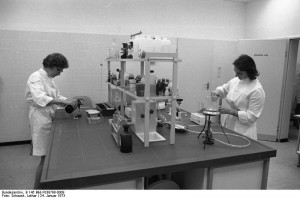three aussie women win science fellowship
It’s a tough go for women in science, but there’s a sigh of relief for three Aussie ladies in lab coats who have been awarded the 2013 L’Oréal for Women in Science Fellowship. This year’s honours went to Dr Kathryn Holt (who is studying the genome of deadly bacteria in epidemics), Dr Misty Jenkins (who’s researching the role of white blood cells in killing off cancer cells), and Dr Jo Whittaker (whose work focuses on the separation of the Indian, Australian and Antarctic tectonic plates).
As part of a broad range of regional and international fellowships set up by L’Oréal, the Australian and New Zealand Women in Science Fellowship awards three $25,000 grants each year to cover research expenses, including childcare.
Fellowships such as L’Oréal’s, and the Australian Academy of Science’s Advancing Women in Research Grant ($10,000 for Level B and C researchers) and the Gender Equity Travel Support Grant (for travel costs incurred while researching) are a step towards more equal outcomes for women in science. All of these grants seem to target women scientists at an especially important time in their careers.
The L’Oréal fellowship is only available for women up to five years after their doctoral research. Similarly, the Academy’s grants are for women in their early to mid-part of their careers. Considering the gender ratio of science research positions becomes unbalanced with men as time goes on, it can be observed the timing of these grants in women’s careers is no accident.
A report released in March by the Academy of Science’s early to mid-career researcher forum revealed approximately half of science-based Philosophy Doctorate candidates in Australia are women. Despite this enormous contribution to Australia’s world-class research, few women can smash through the glass ceiling in their laboratories and institutions. Just four years ago women made up less than 10% of people in the top science positions in universities, the CSIRO, and fellows of a number of academies for the sciences.
As like most industries, the sciences appear to have equality going on. Sure, there are women scientists and there are women scientists in top positions: but again, as like most industries, there are not enough. With anti-discrimination legislation giving women protections against overt means to keep women out of research, the issue comes down to the notably masculine culture of the sciences.
The work of women researchers is less esteemed than that of men, Ohio State University researchers found. Women’s research was less likely to want to be collaborated with and the work of male academics was found to be more important and innovative. However, many women may not pursue a research career as female undergraduate science students are stopped dead in their tracks. Speaking from personal experience in an article for Lip, Stella Crawford reported dwindling numbers of girls in her undergrad chemistry courses over three years due to a profoundly masculine culture. For example, Crawford observed, ‘When word filters through to undergraduates that there’s one professor with a “girls’ lab” and a “boys’ lab” – something is wrong.’
To combat these inequalities, the Australian Academy of Science announced new policies for the workplace in March this year. These include flexible working hours, parenting rooms in laboratories and institutions, female representation in committees, and support and inclusion of women at every level of their career. Ideally, these would be utilised by all institutions and laboratories within the academy. There is also WISENET, the Women in Science Enquiry Network, which offers support to women employed in science. It’s important to note that WISENET acknowledges the propensity of women to use their science degrees in teaching roles as it offers a bursary for Victorian women who go on to pursue a Diploma of Education.
Grants and fellowships specifically for women in science are a wonderful thing, as they allow women opportunities they may not have through the institution they are researching with given the proportion of males in the field. That being said, perhaps if the masculine norms of the sciences wore away with the support of the Academy of Science and WISENET, women scientists would be able to research more readily and easily.


